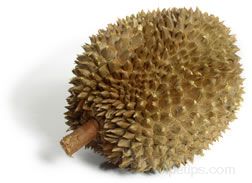There are different varieties of durians, each with a somewhat different flavor and texture. Durians with yellow meat generally have a sweeter flavor while white meat varieties may have a nuttier taste. The inner flesh can be smooth or wrinkled. If wrinkled, the meat is creamier with a bittersweet, somewhat nutty flavor. Smoother skinned durians have a fruitier flavor and a slightly less creamy texture. To prepare, the fruit can be sliced in half between the stem and the bottom or the concave sections can be cut in an elliptical shape and pulled back away from the shell of the fruit. Either method will allow access to the pockets that contain the creamy textured flesh so it can be scooped out with a large spoon for serving. Make sure no juice drips onto any item which can be stained, such as clothing, as it will permanently mark areas where it spills.
Durians should be eaten fresh and not stored at room temperature for more than 3 to 5 days. It is best to select well formed fruits without blemishes. By inserting a knife into a durian it is possible to check for freshness, which is indicated if the residue remaining on the knife is sticky.
The durian fruit can be used in baking sweets, in making jams, for use in custards, or as a flavoring for milk shakes and ice-cream treats.








